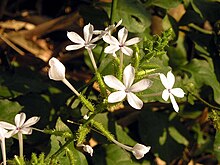| Plumbago zeylanica | |
|---|---|

| |
| Scientific classification | |
| Kingdom: | Plantae |
| Clade: | Tracheophytes |
| Clade: | Angiosperms |
| Clade: | Eudicots |
| Order: | Caryophyllales |
| Family: | Plumbaginaceae |
| Genus: | Plumbago |
| Species: | P. zeylanica |
| Binomial name | |
| Plumbago zeylanica L. | |
| Synonyms | |
|
Plumbago scandens L. | |
Plumbago zeylanica, commonly known as Ceylon leadwort, doctorbush or wild leadwort, is a species of plumbago with a pantropical distribution. Carl Linnaeus described the paleotropical P. zeylanica and Neotropical P. scandens as separate species, but they are currently considered synonymous.
Description
Plumbago zeylanica is a herbaceous plant with glabrous stems that are climbing, prostrate, or erect. The leaves are petiolate or sessile and have ovate, lance-elliptic, or spatulate to oblanceolate blades that measure 5-9 × 2.5–4 cm in length. Bases are attenuate while apexes are acute, acuminate, or obtuse. Inflorescences are 3–15 cm in length and have glandular, viscid rachises. Bracts are lanceolate and 3-7 × 1–2 mm long. The heterostylous flowers have white corollas 17–33 mm in diameter and tubes 12.5–28 mm in length. Capsules are 7.5–8 mm long and contain are reddish brown to dark brown seeds.
Distribution and habitat
Plumbago zeylanica grows throughout the tropical and sub-tropical climates of the world, including Australia and India. In Australia, it grows in the understory of monsoon forests and vine thickets from sea level to 900 m. In Dhofar, Oman, this species is often found growing on Olea trunks.
Ecology
Plumbago zeylanica is a food plant for the Cassius blue (Leptotes cassius), marine blue (L. marina), and zebra blue (L. plinius) during their larval stages.
Traditional medicine
Early folk medicine used the crushed plant internally and externally as an abortifacient. In Ayurveda, P. zeylanica is known as chitrak, meaning "the spotted one". It is used with other herbs to lessen its intense pungency.
References
- ^ "Plumbago zeylanica Linnaeus, Sp. Pl. 1: 151. 1753". Flora of North America. eFloras.org. Retrieved 2011-06-30.
- "Plumbago zeylanica". Germplasm Resources Information Network. Agricultural Research Service, United States Department of Agriculture. Retrieved 2011-02-23.
- NRCS. "Plumbago zeylanica". PLANTS Database. United States Department of Agriculture (USDA). Retrieved 8 October 2015.
- ^ F.A.Zich; B.P.M.Hyland; T.Whiffen; R.A.Kerrigan (2020). "Plumbago zeylanica". Australian Tropical Rainforest Plants (RFK8). Centre for Australian National Biodiversity Research (CANBR), Australian Government. Retrieved 27 May 2021.
- ^ G., Miller, Anthony (1988). Plants of Dhofar, the Southern Region of Oman: Traditional, Economic, and Medicinal Uses. Morris, Miranda., Stuart-Smith, Susanna., Oman. Office of the Adviser for Conservation of the Environment. Muscat: Office of the Adviser for Conservation of the Environment, Diwan of Royal Court, Sultanate of Oman. p. 232. ISBN 0715708082. OCLC 20798112.
{{cite book}}: CS1 maint: multiple names: authors list (link) - "Butterfly Larvae & Host Plants" (PDF). Xerces Society. Retrieved 2018-11-24.
- "Featured Plants Spring 2016" (PDF). Desert Survivors. February 2016. p. 3.
- Pole, Sebastian. Ayurvedic Medicine: The Principles of Traditional Practice. Singing Dragon, 2013. p156.
External links
 Media related to Plumbago zeylanica at Wikimedia Commons
Media related to Plumbago zeylanica at Wikimedia Commons Data related to Plumbago zeylanica at Wikispecies
Data related to Plumbago zeylanica at Wikispecies- Plumbago zeylanica in West African plants – A Photo Guide.
| Taxon identifiers | |
|---|---|
| Plumbago zeylanica |
|